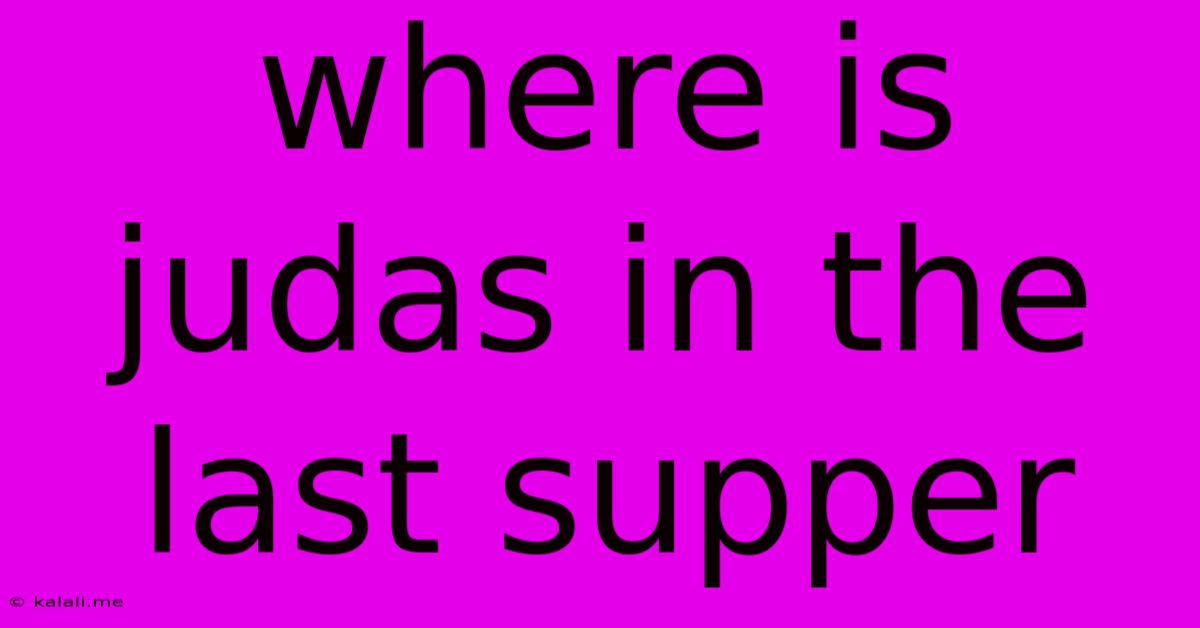Where Is Judas In The Last Supper
Kalali
May 31, 2025 · 3 min read

Table of Contents
Where Is Judas in the Last Supper? A Look at Artistic Interpretations
The Last Supper, a pivotal moment in Christian history, has captivated artists and theologians for centuries. Depictions of this final meal shared by Jesus and his twelve apostles vary, but a common point of interest – and often artistic license – lies in the portrayal of Judas Iscariot, the disciple who betrayed Jesus. This article will delve into the various artistic interpretations of Judas's placement and symbolic representation in famous Last Supper paintings. Understanding the positioning and portrayal helps to understand the artist's message and the evolving interpretations of this biblical scene.
The Traditional Placement: At the Right Hand of Jesus
In many traditional depictions, Judas is seated to the right of Jesus. This positioning often reflects the Gospel accounts where Judas is described as one of the closest disciples to Jesus. However, this placement is not universally adhered to, and artists have taken creative liberties with his location to emphasize specific aspects of the narrative. The exact location isn't explicitly stated in the Bible, allowing for artistic interpretation and symbolic emphasis.
Artistic Choices and Symbolic Meanings
Artists have used various techniques to visually differentiate Judas from the other apostles. Some common methods include:
- Separate Placement: Some artists strategically place Judas apart from the other apostles, emphasizing his isolation and impending betrayal. This visual separation highlights his role as an outsider within the close-knit group.
- Facial Expressions: Judas's facial expression is often portrayed as dark, troubled, or even sinister, contrasting sharply with the expressions of the other apostles. The use of shadow and light can also emphasize this difference.
- Body Language: His body language – perhaps slumped, withdrawn, or in a gesture of defiance – can further highlight his separation and internal conflict.
- Distinctive Clothing: In some paintings, Judas's clothing may differ in color or style from that of the other disciples, acting as a visual cue to identify him.
- Darker Palette: The overall palette used to depict Judas might be darker, symbolizing his internal darkness and impending betrayal.
Leonardo da Vinci's Masterpiece: A Case Study
Leonardo da Vinci's The Last Supper is arguably the most famous depiction of this biblical scene. In da Vinci's rendering, Judas is seated on the opposite side of the table from Jesus, slightly separated from the other apostles. His posture, demeanor, and even the shadows cast upon him emphasize his isolation and inner turmoil. Da Vinci’s use of perspective and chiaroscuro helps to highlight Judas's distinct emotional state.
The Significance of Interpretation
The varying interpretations of Judas's placement and representation throughout history reflect the evolving understanding and interpretation of the Last Supper's theological significance. Artists have used their creative license to emphasize different aspects of the narrative, focusing on elements such as betrayal, redemption, and the complex dynamics of faith. Each artist's choice offers a unique lens through which to view this pivotal moment in Christian history.
In conclusion, the precise location of Judas in The Last Supper varies across different artistic representations. While some adhere to a traditional right-hand placement, others use artistic liberties to emphasize Judas’s isolation, betrayal, and internal struggle. The choices of artists provide valuable insight into their interpretation of the narrative, showcasing the enduring power and complexity of this iconic biblical scene.
Latest Posts
Latest Posts
-
How To Get House In Riften Skyrim
Jun 02, 2025
-
How To Backfeed A Generator Into Your House
Jun 02, 2025
-
Sed Re Error Illegal Byte Sequence
Jun 02, 2025
-
How Long Is Cream Cheese Good After Expiration Date
Jun 02, 2025
-
How To Get Companions Out Of Power Armor Fallout 4
Jun 02, 2025
Related Post
Thank you for visiting our website which covers about Where Is Judas In The Last Supper . We hope the information provided has been useful to you. Feel free to contact us if you have any questions or need further assistance. See you next time and don't miss to bookmark.